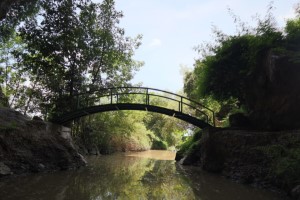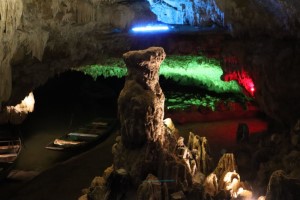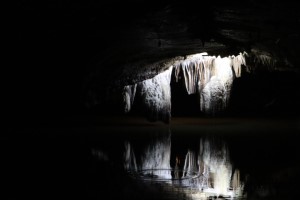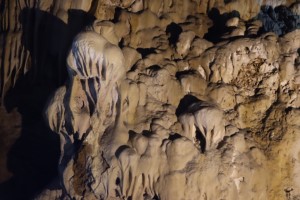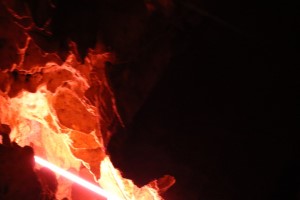Thien Ha cave (Động Thiên Hà) is hidden within Tuong mountain in the Trang An mountain range of Ninh Binh. While only a short distance from the main tourist centers as the “crow flies”, it can be a considerable challenge to actually get there.
Long considered a natural bulwark and watch tower to protect the ancient Hoa Lu citadel, the Trang An mountains are riddled with secret retreats and sanctuaries. Thien Ha cave is a beautiful living cave with both dry and wet areas and variety of very unusual stalagmites/stalactites intact and still being formed.
Located in Sơn Hà commune of the Nho Quan district it is relatively isolated. 11km from Tam Diep or 24km from Ninh Binh city, with much of the journey along heavily used arterial trunk roads. Unless you have a self-drive vehicle or join a tour group, a chartered taxi or car might be the only way to visit. As far as we are concerned, like many of the more isolated spots in Ninh Binh, the destination is truly worth the journey.
Muong People
The accepted way is to first get to the ethnic Muong village of Tho Ha in Son Ha. A few hundred metres from the main road is the Ben Dang (Bến Đang) river wharf, aka the Galaxy Grotto Tour Center. Signs are well posted on the main road but if you self-drive, don’t search for “Thien Ha” but rather “Galaxy Grotto Tour Center”. Otherwise Google will send you in loops as there is no vehicular access to the cave. Just follow the signage or ask the locals – most will already know what you are looking for.
The Tour Center is a well appointed way station for the short (1km) boat ride along a tributary of the Ben Dang River to the cave dock. There you will find a stone walking track that has been constructed to take you the final 500m to the foot of Tuong Mountain and the Thien Ha cave entrance.
Tuong Mountain itself is around 200meters high and is part of a trio of peaks that have formed a natural rock fortress that has protected Hoa Lu since at least the 10th Century. But here you go under, not over this legendary buttress. Largely forgotten for a millennia, the Thien Ha Cave is estimated to be around 700 meters of river cave while a nearby secondary cavern of around 200 meters in length is called the “dry” cave.
World Heritage
In 2008, several local archaeologists discovered a collection of mollusk shells mixed with coal ash. Researchers proposed that a prehistoric Vietnamese society left these remains thousands of years ago. In 2012, the Institute of Archaeology and the Management Board of the Trang An Landscape Complex surveyed Thien Ha Cave and submitted documentation to UNESCO for recognition as a World Heritage Site.
Archaeologists found hewn rock tools, thick-walled ceramic shards, and burnt terrestrial animal bones along with mollusk shells. They tested the animal carcasses and mollusk shells and dated them to the Holocene age, while they estimated the site to date back to the Middle Neolithic era, around 9,000–7,000 BC. It also showed signs of human habitation to at least the Late Neolithic era (4000 BC). Which is the technical way of saying that not only is it a stunning tourist attraction but that it is also a very important archeological site.
“Wet” Cave
A first thought is perhaps that the name Galaxy Grotto came about due to rock formations of some planetary or star type images. Instead, some of the more interesting stalactites/mites actually resemble a variety of alien life forms with tentacles, giant brains, spiny growths, evil jaws and melting skulls.
Under the towering limestone mountain, in the cool earthy silence backlit by the flickering shadows of filtered light, it is hard to be critical of the imaginings of the early settlers. Even with full knowledge of the geological processes involved, it still remains an awesome experience.
Entering the main cavern, visitors climb down a steep but short stone stairway to a large open cavern at the end of which is the internal boat wharf. From here, visitors can take a surreal boat ride through the “wet cave” which gave the place its name of Milky Way or Galaxy Grotto. Colorful lights theatrically illuminate the winding river cave, where countless beautiful, shimmering limestone protuberances line and pockmark the walls.
Dripping water and the echo of oars in this natural amphitheater humble visitors, reminding them of nature’s majesty and the bravery of distant ancestors who once ventured deep into this alien environment.
“Dark” Cave
The cave meanders for some distance, firstly through the backlit main area and then, if you have booked for the full tour, into the unlit “Dark Cave”. Tourists shine their provided torches into secluded alcoves, startling tiny Vesper bats from their roosts and sending them fluttering overhead or into the nearby distance.
If you angle the torch right, the roof suddenly appears as a mirror image on the stream surface. This gives the the sensation of hovering through the center of these spectral caves, with formations appearing both above and below. Truly a beautiful and unique experience for even the most jaded of travelers.
Near the end of the Dark Cave is a stalactite formation that resembles the Buddha themself. Unlit bar the flickering light of the provided torches, with thousands of tonnes of mountain above you, protected only by a ceiling of encroaching stalagmites, the barely audible drip of mineralized water oozing through the porous rock, the fluttering of small bats and the steady splash of the boat oars, it is not difficult to lose all sense of direction and self, a sort of sensory deprivation that is both soothing and thrilling at the same time. Buddha would be proud.
And no, there is no internet or mobile coverage here…
Dry Cave
If you have time, the smaller yet still spectacular Thien Thanh cave is located back at the main boat dock. Using a trail cut into the living mountain, visitors can climb the 157 stone steps to reach the cave perched 100 meters or so in the side of the mountain. This is the Thien Thanh cave which is “dry” and smaller than its bigger sibling below.
While not as long as the wet cave, there are many layers of stalagmites and stalactites that have contributed to the depth and richness of the cave. The stalactites continue in a diversity of shapes from the limestone and gypsum that gave them life.
If you come without a guide, only the dry cave will be accessible – you really have to have a local and knowledgeable boat captain to guide you through the wet areas. But the dry cave is about 40m wide and filled with many formations illuminated by crevices in the ceiling to produce an other-worldly light show, highlighting the graceful and sometimes grotesque shapes in gold, silver and other colors. As is typical in the Vietnam, the locals have anthropomorphized the geological formations into a stone castle guarded by … aliens??
Travel Tips:
At the time of writing, there is no kiosk or café at the cave so if your intention is to stay a while, some bottled liquid and prepared snacks will make the trip more enjoyable.The Tour Centre offers limited water and soda, and staff prepare meals for tour groups but not for individual visitors. Since water surrounds much of Thien Ha, bring insect repellent. Wear strong, flat-heeled shoes and use a water and dust-proof cover to protect any sensitive electronic devices.
There is auxiliary lighting so a flashlight is not a necessity except in the “dark cave” where the “Buddha” stalagmite sits – your boat captain will have torches ready for this section. In the summer months, the strong tropical sun shines through the small nicks and crannies in the porous rock canopy, making visits to Thien Ha especially rewarding. At such moments, Thein Ha cave comes alive with in a glittering photographic display of one of Mother Nature’s finer moments
Ticket Prices.
Currently, the ticket price to visit Thien Ha cave in Ninh Binh is between 150,000 and 250,000 VND per person. Just remember that you pay a “shared” boat price, which means each person pays for a spot on a two-person boat. If you are traveling alone, you will need to pay for the empty seat or bargain hard.
While not the cheapest entry fee in Ninh Binh, it is still excellent value. And remember, a good part of the fee goes towards the preservation and the display of the cave site and to pay the guides and workers from the local community. There has been talk of further expansion, along the lines of Thang An and Tam Cot though it is perhaps selfish to hope that the grotto remains relatively undiscovered, a place of quiet, peace and wonder for sometime to come.



